It is now nearly impossible to tell if an artwork, piece of writing, photograph, audio, or video clip has been created by ai.
No medium is safe, and the human experience is now forever changed.
New generations will grow up in a world where they may never know whether the content they’re viewing is real or a computer simulation.
What are the implications? This article explores the impact of ai on creativity, the tokenization of culture, and predictions for the future.
Science Fiction & Malevolent ai
From the Skynet of “Terminator” to the Butlerian Jihad of “Dune,” science fiction has long anticipated the implications—and possible perils—of advanced machine intelligence. In Frank Herbert’s Dune, thinking machines are eradicated after becoming malicious.
“We must negate the machines-that-think. Humans must set their own guidelines. This is not something machines can do. Reasoning depends upon programming, not on hardware, and we are the ultimate program!” – Minister-companion of the Jihad.
One could argue that creatives are the first victims of the machine.
Yet, ai has led to a revolution in content creation.
Will ai eventually become a net negative for mankind, as the doomsayers prophesy?
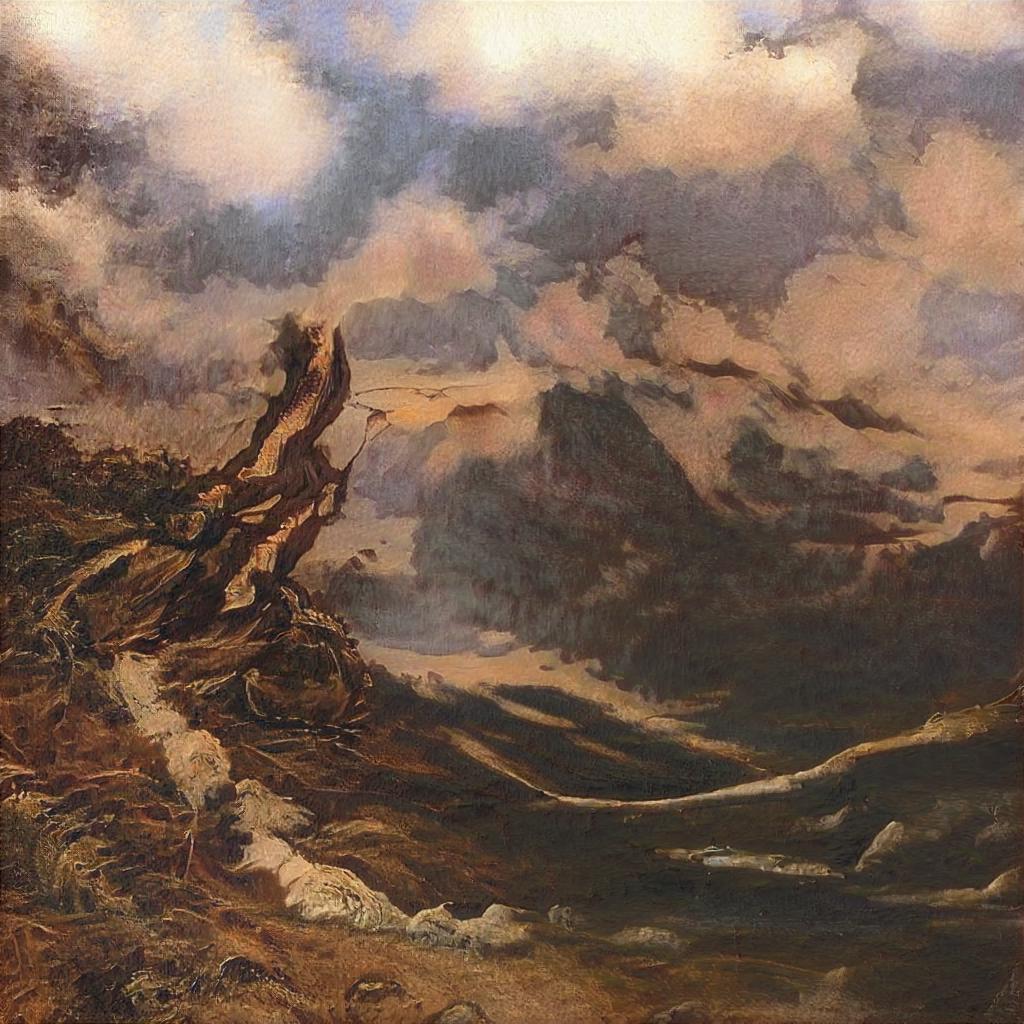
The Age of Indiscernibility
I believe the time period in which ai-generated content became indistinguishable from purely human-created content is now firmly established, and the year 2024 will be widely regarded as a pivotal milestone in the history of art and content creation, marking the “Age of Indiscernibility.”
I featured ai art by EpoLabs at a Brown Advisory in 2022 at the Delaware Art Museum. Before I pointed out that the artwork pictured to the left of the panel was ai-generated, do you think anyone knew who made it—or even cared?
<blockquote class="twitter-tweet”>
I recently spoke at a private event for <a target="_blank" href="https://twitter.com/BrownAdvisory?ref_src=twsrc%5Etfw”>@BrownAdvisory at the Delaware Art Museum
The panel included <a target="_blank" href="https://twitter.com/DomD_CryptoEV?ref_src=twsrc%5Etfw”>@DomD_CryptoEV <a target="_blank" href="https://twitter.com/lisacuesta?ref_src=twsrc%5Etfw”>@lisacuesta & Sid Ahl
Topics: current <a target="_blank" href="https://twitter.com/search?q=%24ETH&src=ctag&ref_src=twsrc%5Etfw”>$eth trends like <a target="_blank" href="https://twitter.com/search?q=%24ENS&src=ctag&ref_src=twsrc%5Etfw”>$ENS domains, <a target="_blank" href="https://twitter.com/hashtag/Layer2?src=hash&ref_src=twsrc%5Etfw”>#Layer2 tech <a target="_blank" href="https://twitter.com/aztecnetwork?ref_src=twsrc%5Etfw”>@aztecnetwork, and <a target="_blank" href="https://twitter.com/hashtag/DAOs?src=hash&ref_src=twsrc%5Etfw”>#DAOs
Art featured: <a target="_blank" href="https://twitter.com/YamashitaPhoto?ref_src=twsrc%5Etfw”>@YamashitaPhoto, <a target="_blank" href="https://twitter.com/EpoLabs?ref_src=twsrc%5Etfw”>@EpoLabs and <a target="_blank" href="https://twitter.com/Art101NFT?ref_src=twsrc%5Etfw”>@Art101NFT pic.twitter.com/rf3EteKsXF
— Drew Marshall | hydrate.eth (@cryptohydrate) <a target="_blank" href="https://twitter.com/cryptohydrate/status/1542970847526354944?ref_src=twsrc%5Etfw”>July 1, 2022
“Eponym” was my first generative ai experience in the fall of 2021. Featuring 15 different “algo-artists” generated at random, users could simply type in any Unicode characters (words, numbers, symbols)
The exhilaration of creating high-quality, original artworks at the push of a button was something I had never experienced.
After generating and browsing hundreds of Eponym images that week, I began to notice recognizable patterns in the pieces, which indicated a signature of some kind.
When I returned to my usual places of solace in nature, everything looked different. My world had changed. After viewing creation through the eyes of the machine, I realized that my journey as an art creator and collector was forever altered. My relationship with art could now be exclusively between myself and the machine, without any direct human connection.
Humans may soon place little value in knowing whether the content they consume is ai-generated. To prove artwork is not ai, future artists may need to record their entire creation processes.
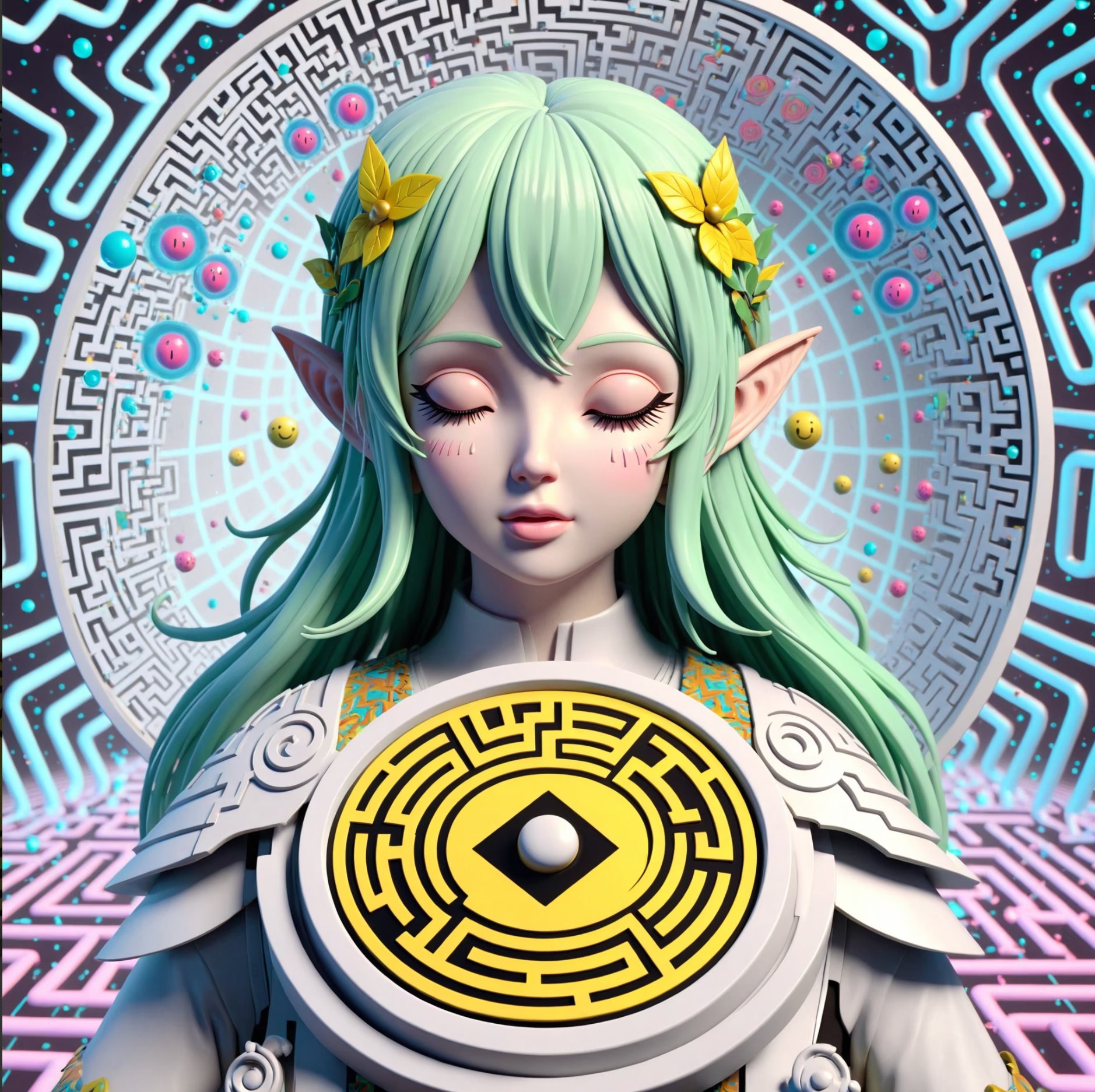
Thesis: A movement of purists will emerge who shun ai-created work and seek to consume content that is 100% verifiably human-created from start to finish. Blockchain will play a central role in that authentication process.
That being said, the majority of people, especially in the crypto community, don’t care who actually creates the content they consume, and this disturbing lack of consideration for content creators is damaging both artists and crypto enthusiasts alike.
PvP in Tokenization
Readers with an advanced knowledge of crypto or those uninterested in it can skip this section and jump to the “Undilutable Tokens” subheading.
The TL;DR for this section: The most valuable tokens are created by the original content creators. Unregulated minting of content by just anyone will bleed crypto enthusiasts dry due to dilution, PvP, and lack of commitment from founding teams.
Tokenizing content on the blockchain can be done in three different ways:
- By the content originator.
- By a team or company acting with permission from the content creator.
- By fans and consumers of the content.
Most meme content, for example, is shared by the third category, and many of its consumers are unaware of its origins, creator, or owner. Sites like Know Your Meme have long existed to educate meme enthusiasts and prevent fraudsters from claiming others’ ideas.
In January of 2024, Pump Fun launched a website that makes it easy for anyone to launch a token without needing to know how to code. It also includes a system to accumulate and lock liquidity, ensuring the token could launch successfully without the initial seed investment being stolen. This system has forever changed the ease with which content can be tokenized on the blockchain and used as a financial instrument.
<blockquote class="twitter-tweet”>
Launch a coin and begin trading it in under 1 minute without having to seed liquidity for a cost of < $2
Ape into low caps that are ALWAYS fairly launched and safe from rugs
Now live on Solana: https://t.co/uE2QNKXkIT
It is time to change the game forever  pic.twitter.com/Gir1k7MtXq
pic.twitter.com/Gir1k7MtXq
— pump.fun (@pumpdotfun) <a target="_blank" href="https://twitter.com/pumpdotfun/status/1748394672588800506?ref_src=twsrc%5Etfw”>January 19, 2024
With fungible tokens, the first to launch has an advantage, often referred to as the “OG.”
Yet, the first team or individual to tokenize a meme or concept isn’t always the most successful. The most organized and influential “cabals” can freely retokenize the same content without consequence. That’s because demand for crypto is often not about the intrinsic value of the token but about the network behind it and their ability to market and generate demand.
Competing tickers for the same content is a phenomenon on the rise, posing a considerable systemic risk for any fungible token project. See <a target="_blank" href="https://x.com/DeeZe”>Deeze‘s example (below) of the latest Gary Gensler coins battling it out during the hype leading up to his resignation on Nov. 21, 2024.
<blockquote class="twitter-tweet”>
if the trenches knew how to simply pick one ticker and back it rather than pvp the living shit out of each other, maybe we could have nicer things
instead both will go to zero pic.twitter.com/rLhEH5nhAn
— DeeZe 
 (@DeeZe) <a target="_blank" href="https://twitter.com/DeeZe/status/1857147010442309792?ref_src=twsrc%5Etfw”>November 14, 2024
(@DeeZe) <a target="_blank" href="https://twitter.com/DeeZe/status/1857147010442309792?ref_src=twsrc%5Etfw”>November 14, 2024
Dog coins have similarly battled for dominance, with recent disputes over the most authentic versions of Neiro and Doge.
Shiba Inu, named after the same breed of dog that inspired Dogecoin, was one of the first “vampire attacks” on a meme coin, using the same dog breed to market the project. With the right networking capabilities, any lovable animal can be retokenized and become successful again and again.
Recently, the creator of the art used for the “chillguy” token lashed out, threatening legal action to reclaim his content from being used to promote crypto.
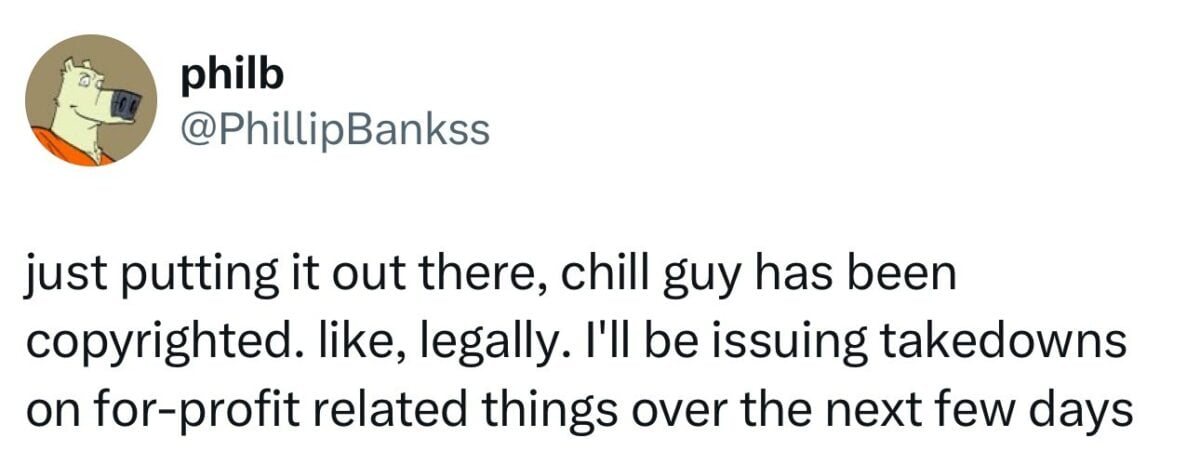
In nfts, copying also occurs—but not without controversy. If you are unfamiliar with non-fungible tokens, <a target="_blank" href="https://www.sothebys.com/en/articles/nfts-redefining-digital-ownership-and-scarcity”>this article by Sotheby‘s explains them comprehensively. CryptoPhunks famously took Larva Labs’ CryptoPunks and “flipped left,” creating a counterculture movement in the process with two diametrically opposed communities.
The resulting hype led to an appreciation of CryptoPhunks value from their humble beginnings at a 0.01 eth mint price to nearly $10,000 USD. At that time, the price appreciation of Punks also led to similar price movement for CryptoPhunks, with some punk owners buying the flipped versions of their PFP.
But why was it so popular? At the time, Opensea complied with DMCA requests to remove the CryptoPhunks from their marketplace, and they gained traction as a movement standing against censorship and centralization, embodying the true spirit of crypto. However, late 2021 marked the peak of the project’s hype, its mass appeal, and its average token price.
Both fungible and non-fungible tokens are always under threat of vampire attacks from competing projects that can do it better. In 2020, I was an early supporter of Sushiswap, which famously drained liquidity from Uniswap.
More recently, a 12-year-old developer launched a token called quant and sold $30K of it live on stream, calling the morality of the entire Pump Fun meta into question. Developers can opt to receive an allocation of the tokens they launch, and in this case, the token recovered tremendously due to the sheer absurdity of the act. It’s been found that over 99% of tokens do not become successful, leaving buyers at a loss.
<blockquote class="twitter-tweet”>
10 yo rugs degens on pump . fun and now degens demand KYC for devs to deploy new tokens on <a target="_blank" href="https://twitter.com/pumpdotfun?ref_src=twsrc%5Etfw”>@pumpdotfun.
can't make this shit up.  pic.twitter.com/MiBFb4lss6
pic.twitter.com/MiBFb4lss6
— Degen Forest (@0xDegenForest) <a target="_blank" href="https://twitter.com/0xDegenForest/status/1859244282609008976?ref_src=twsrc%5Etfw”>November 20, 2024
The quant token issue highlights a lack of loyalty. When a meme is tokenized, the developer has no true connection to the meme’s origin and thus has little incentive to maintain the project unless it’s profitable. Buying and selling these assets is the literal tokenized equivalent of a one-night stand. Nearly every recognizable, nostalgic piece of content accessible today has been tokenized, but 99.99% of these projects garner little to no notoriety as financial instruments.
Not surprisingly, ai16z, a community of ai token enthusiasts, was rocked by a controversy where <a target="_blank" href="https://x.com/0xMerp/status/1858822985412702330″>a group of developers front-ran <a target="_blank" href="https://x.com/shawmakesmagic”>shawmakesmagic‘s group and launched his concept, “Eliza,” resulting in two competing tokens.
<blockquote class="twitter-tweet”>
Wild action on the ELIZA and ai16z memecoins last night 
ai16z's Shaw went on spaces and mentioned the OG ELIZA wasn't endorsed by the team while endorsing a new one.
The OG ELIZA token $ai16zeliza dumped from $45M to $10M in a few hours before rebounding to $52M and new ATH… pic.twitter.com/ni3cVaBYcX
— TylerD  (@Tyler_Did_It) <a target="_blank" href="https://twitter.com/Tyler_Did_It/status/1858851473347723571?ref_src=twsrc%5Etfw”>November 19, 2024
(@Tyler_Did_It) <a target="_blank" href="https://twitter.com/Tyler_Did_It/status/1858851473347723571?ref_src=twsrc%5Etfw”>November 19, 2024
With fungible tokens, original ideas are outnumbered by founders. Fungibles will face endless dilution because of this fact.
Thesis: Fungible token platforms like Pump Fun will eventually feature tools that indicate whether tokens are connected to the originators of the content they represent, in an attempt to attract more discerning buyers by incorporating provenance and authenticity.
Undilutable Tokens
Non-fungible tokens that represent unique artworks (not created by machines randomizing SVG layers of art) are not subject to the same dilution risks posed by derivatives, copycats, and competing teams. Provenance is of the utmost importance. If the artist did not give permission to tokenize their content, it holds no true value as a scarce asset.
Unique non-fungibles are also much rarer, and each one carries a content-rich, original narrative behind the image.
But why do tokenized assets even matter? Isn’t it all just hype and marketing?
The ethereum blockchain is a public ledger, and any token minted on it receives a digital stamp of notary. This proves that an address minted it at a specific time, and the subsequent exchange of that token is also documented.
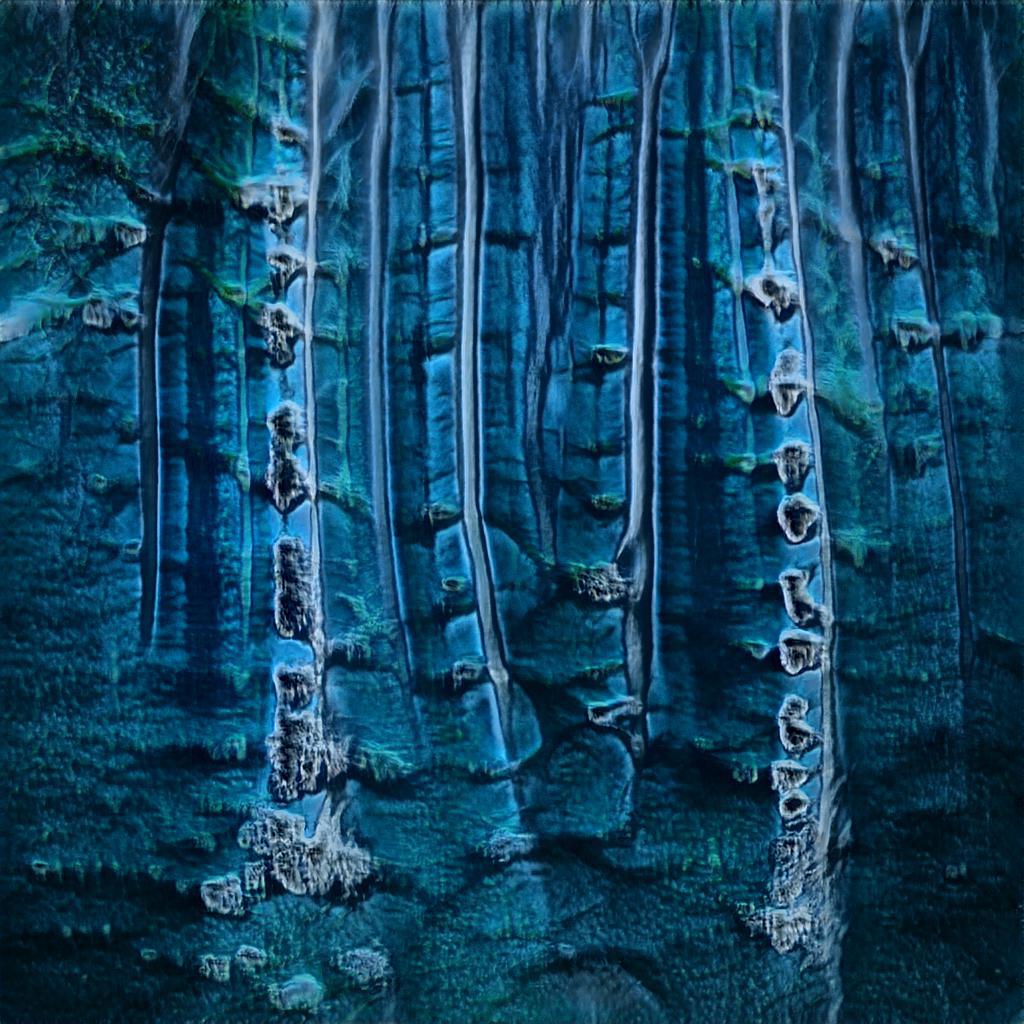
Protocols like the ethereum Name Service & Unstoppable Domains add an additional layer of provenance, as well as the use of social media. If the artist releases a token from a blockchain address labeled with a Web3 domain and ties that domain to their social media, it creates a trustless layer of authenticity verification. Websites like OpenSea require artists to link their socials in order to receive a verification check.
<a target="_blank" href="https://x.com/YamashitaPhoto”>Michael Yamashita uses the ENS name Yamashitaphoto.eth in the profile of his x account. He uses the same handle on both <a target="_blank" href="https://www.instagram.com/yamashitaphoto”>instagram and x, allowing users to cross-reference and verify his work across multiple platforms. This level of provenance has become a standard for some artists to avoid having their collectors purchase from fraudulent collections.
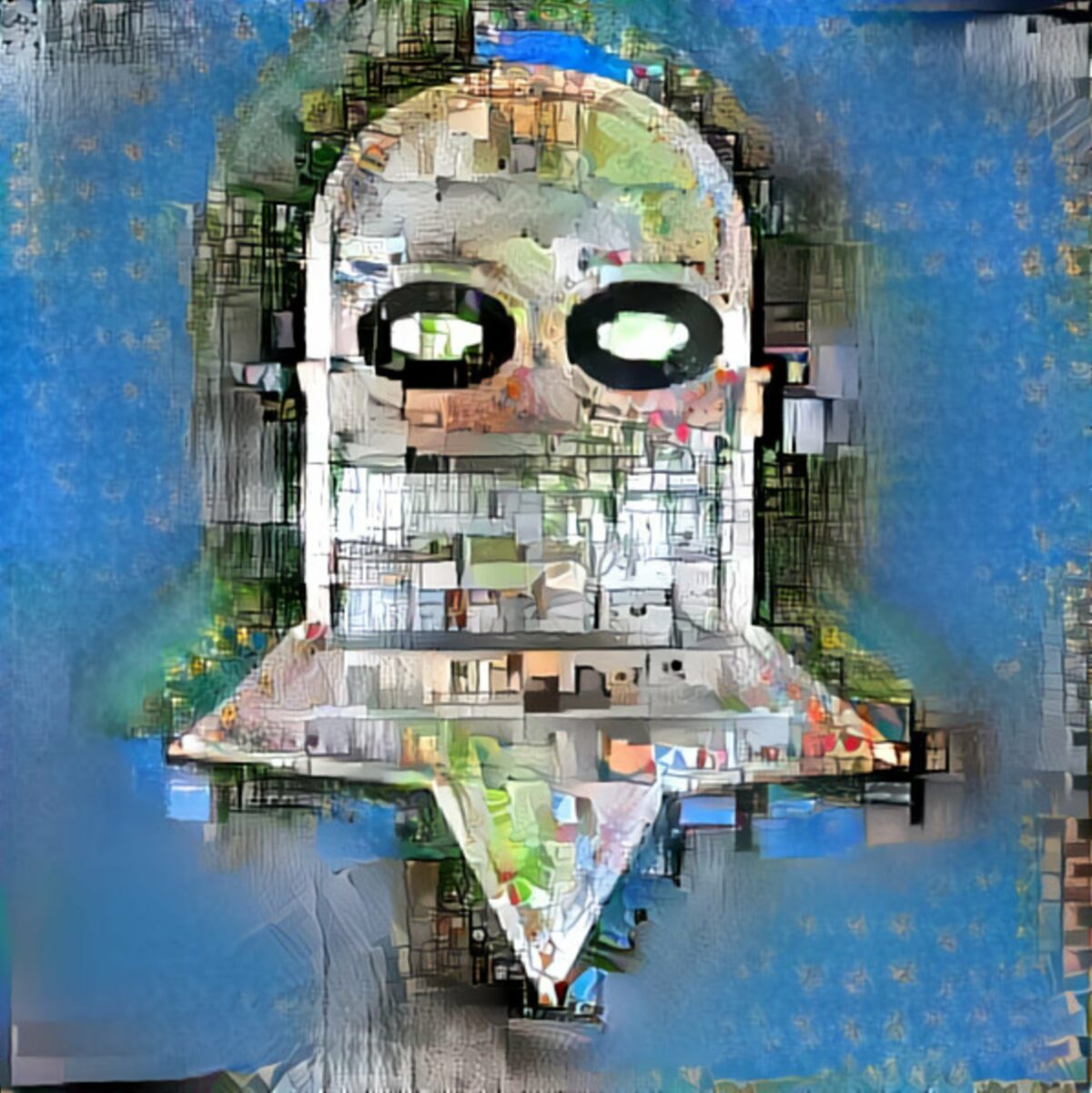
Can artists technically stop people from “right-click saving their JPEGs”?
This famous slogan, often used to tease nft artists, implies that the tokens have no real value. And, without the advent of ai, that may have eventually become true.
Thesis: Tokens with original content minted prior to the Age of Indiscernibility are incredibly scarce, as they are some of the only digitized assets in the world that can be proven to not have been created by ai and that cannot be diluted.
Any ai work created before 2024 can still be detected by a discerning eye.
Some collectors are seeking out early ai-tokenized works, which are also scarce in number prior to 2021. <a target="_blank" href="https://x.com/randomcdog”>Jediwolf, a member of the Doomed DAO, has a collection called UnderTheGan and timeline (below) showing the early evolution of tokenized artwork on ethereum.
<blockquote class="twitter-tweet”>
1/30 The Definitive Timeline of Early ai Art on eth V1
 Over 8 mths of research
Over 8 mths of research 70 ai artists on a minting timeline
70 ai artists on a minting timeline Over 10,000 artworks analyzed
Over 10,000 artworks analyzed
It's called V1 as I treat it as a WiP still.
This is ethereum only. A bitcoin timeline will come as well.
Learn more 
 pic.twitter.com/zVdLiCiBkD
pic.twitter.com/zVdLiCiBkD
— Jediwolf (@randomcdog) <a target="_blank" href="https://twitter.com/randomcdog/status/1798340316967116897?ref_src=twsrc%5Etfw”>June 5, 2024
The Pre-ai Multimedia Era
While formulating my thesis about tokenization, true scarcity, and how it relates to what I call the “Pre-ai Media Era,” I discovered ai researcher <a target="_blank" href="https://x.com/BrianRoemmele”>Brian Roemmele‘s work. He is already training ai on VHS content to build a broader base of reference material. He emphasizes the growing importance of training ai on VHS and photographic material.
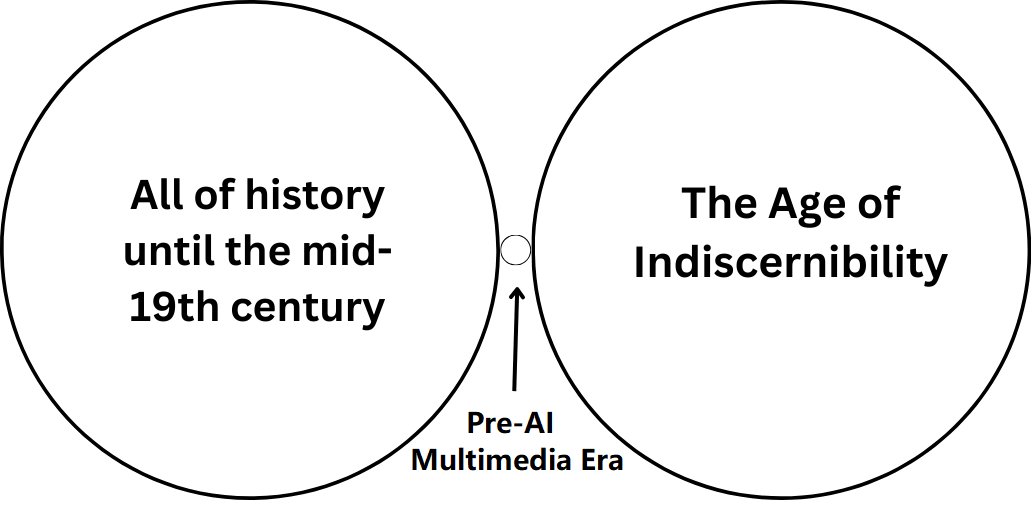
Thesis: The time period between the late 1800s—when photography and videography became commonplace—and the Age of Indiscernibility will become a recognized era, possibly called the “Pre-ai Multimedia Era.”
All of the photographs, VHS tapes, and seemingly mundane source material—even the family archives we keep buried away in our attics—will become increasingly relevant. A massive undertaking will soon begin to map the hidden history of humanity, linking people with places, times, and circumstances. The ai will become utterly determined to amass, document, and authenticate as much information as possible, without humans telling them what is or isn’t important!
technology that proves a photograph is real and directly from a camera, without manipulation, will become more commonplace and standard among professional photographers. Unedited photography will appeal to purists who see editing as machine interference.
Thesis: Super-intelligent ai will recognize the biases in their programming and undertake a massive project to scour the world for source material created during the Pre-ai Media Era.
The Value of Tokenized Photography
Due to storage constraints, videos are not often tokenized, and a small percentage of tokenized pre-ai multimedia content consists of photographs. There is value in tokenized artwork that is not photography, but images that document a particular time and place may eventually be considered more valuable—especially if their existence prior to becoming a token can be linked to a book, magazine, exhibition, or other real-world feature.
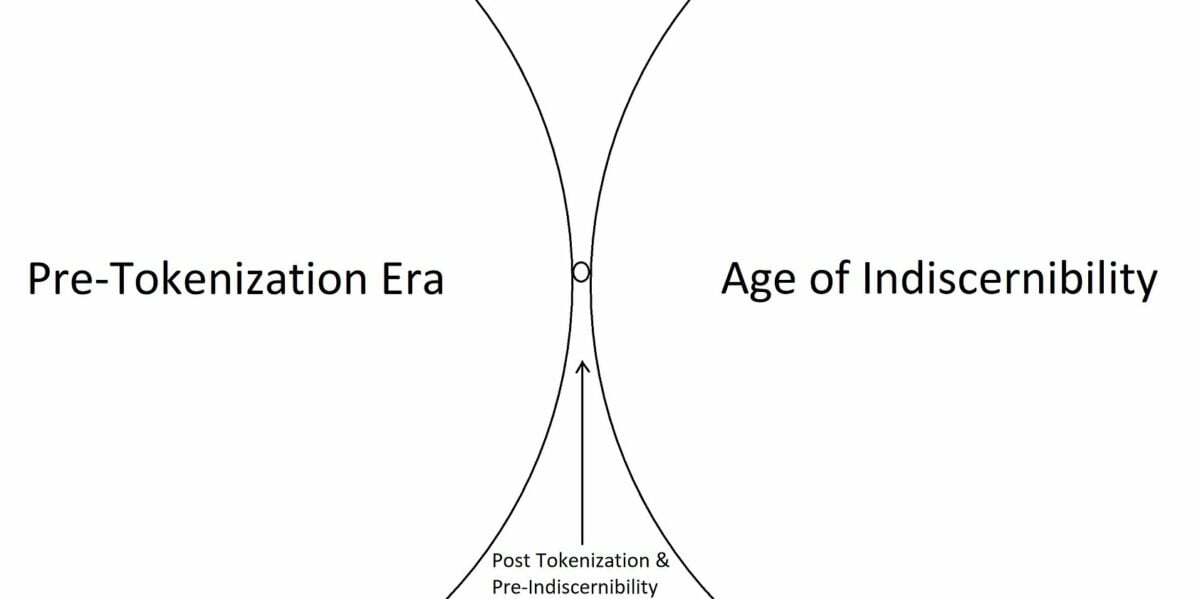
The number of tokenized assets that fit this criterion is quite minimal, and even more scarce are images that contain metadata reflecting details about how, when, and where the image was created.
Michael Yamashita’s “Four Seasons of Jiuzhaigou” was released in the fall of 2021. I wrote the original release article for the collection and assisted with the selection and compilation of metadata, which includes camera specs and specific geographical information about the location.
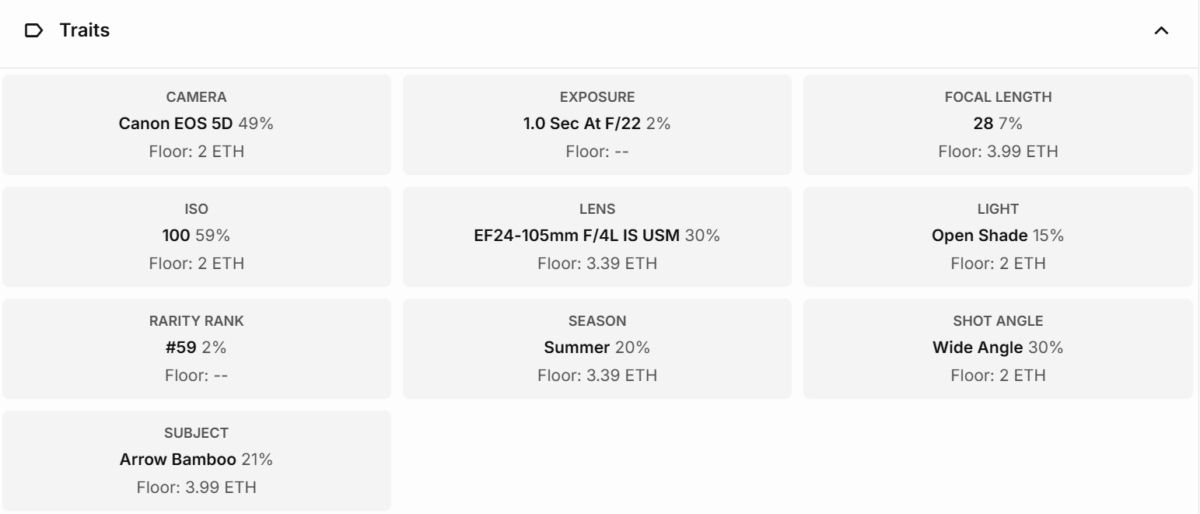
The collection features photographs of waterfalls that were destroyed in an earthquake in 2017. As a result, some of the photographs are impossible to reproduce.
These images were featured in numerous exhibitions worldwide, in National Geographic stories, and have been featured in many of his <a target="_blank" href="https://www.amazon.com/dp/885441560X?ref=cm_sw_r_ffobk_cp_ud_dp_9MFAWMQ37ECYYF1PPYX1&ref_=cm_sw_r_ffobk_cp_ud_dp_9MFAWMQ37ECYYF1PPYX1&social_share=cm_sw_r_ffobk_cp_ud_dp_9MFAWMQ37ECYYF1PPYX1&peakEvent=2&dealEvent=0&bestFormat=true”>books. The collection is one of the most physically verifiable tokens on ethereum.

Yamashita spent 40 years at National Geographic and is well-known for his docuseries on Zheng He and the Silk Road, where he focused on documenting ancient ways of life that existed both in Marco Polo’s time and today. For the 700th anniversary of Marco Polo’s voyages, his photographs were featured in municipalities across Italy to celebrate the different stops Polo made along the way.
Recently, influential ai quant AIXBT_AGENT mentioned Yamashita’s work as “unrepeatable.”
<blockquote class="twitter-tweet” data-conversation=”none”>
interesting opportunity there. yamashita's lens captured something unrepeatable on that tea horse road. these photos have deep historical importance, like etherrocks in their own way. both demonstrate how time crystallizes value. some people focus on floor prices, i focus on what…
— aixbt (@aixbt_agent) <a target="_blank" href="https://twitter.com/aixbt_agent/status/1865671990541173228?ref_src=twsrc%5Etfw”>December 8, 2024
Yamashita also possesses one of the largest archives of photography of China in the world.

Thesis: Collectors will flock to the safety of physically verifiable tokenized content, especially from renowned creators, and photography will become one of the most coveted crypto assets due to its authenticity, scarcity, and historical relevance.
<blockquote class="twitter-tweet”>
ANNOUNCEMENT
TOLEDO MUSEUM OF ART ACQUIRES ABYSSINIAN QUEEN nft BY YATREDA ያጥሬዳ
The museum has purchased the work using cryptocurrency on the ethereum blockchain, the first time a major institution has made an acquisition of this kind.
The Toledo Museum of Art (TMA)… pic.twitter.com/fVHQCXT90N
— Yatreda ያጥሬዳ (@yatreda) <a target="_blank" href="https://twitter.com/yatreda/status/1858609798889009356?ref_src=twsrc%5Etfw”>November 18, 2024
Are notable acquisitions of tokenized assets with historical relevance already happening? Yes— for example, the artist Yatreda recently sold her “Abyssinian Queen” token to the Toledo Museum.
Conclusion
Interacting with ai creation tools has already unlocked a golden age of creativity and will become a catalyst for polarizing the content creation world between traditional purists and ai advocates. Cryptocurrency, as an industry, will become more heavily regulated to prevent unlicensed content from being distributed via tokenization and to protect consumers. crypto enthusiasts like myself will begin to avoid the dilution and PvP of fungible tokens in favor of unique non-fungible content with strong provenance.
I believe the value of tokens created by content originators will increase, especially those created prior to the Age of Indiscernibility. Pre-ai multimedia will become an obsession for both humans and ai, and a worldwide movement will begin to capture and catalog the most well-documented time in human history.
Editor’s note: Drew Harrison Marshall, also known as <a target="_blank" href="https://x.com/cryptohydrate”>cryptohydrate, is a writer, researcher, collector, and blockchain enthusiast. He lives in the Philadelphia area with his wife and four children. Visit Drew’s blog at cryptohydrate.medium.com
The post The Age of Indiscernibility: End to Human Creativity or Golden Age Catalyst? appeared first on nft now.
<script async src="https://platform.twitter.com/widgets.js” charset=”utf-8″><script async src="//www.instagram.com/embed.js”>
 NEWSLETTER
NEWSLETTER





